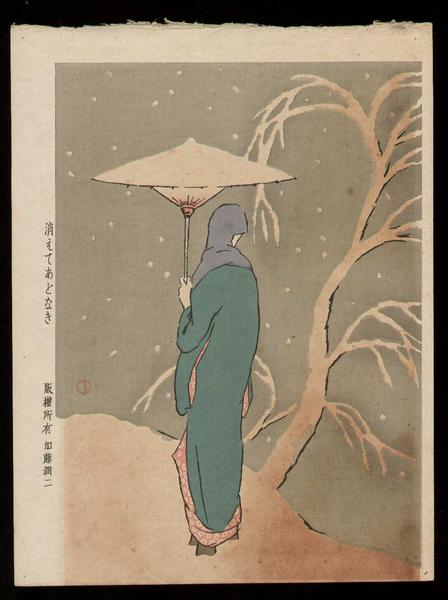| | |
| Artist: | Takehisa Yumeji (1884-1934) — 竹久夢二 |
| Title: | When the Flame Goes Out — きえてあとなき |
| Series: | Yumeji Masterpieces — 夢二名作集 |
| Date of first edition?: | 1929 |
| Publisher (first edition)?: | Kato Junji |
| Publisher (this edition)?: | Kato Junji |
| Medium (first edition): | Woodblock |
| Medium (this edition): | Woodblock |
| Format (first edition): | Aiban
|
| Format (this edition): | Aiban |
| DB artwork code: | 39950 |
| Notes (first edition)?: |
|
| Notes (this edition)?: |
| The following information was taken from the original web listing of this artwork. Note that there may be some inaccuracies:
Monday, 18 December 2006
Woman in Snow titled Kieatonaki (When the Flame Goes Out) by Yumeji Takehisa. Original Japanese woodblock print circa 1929. Title and Kato Junji publisher's seal in left margin. Yumeji red seal on left side of print. Printis is Fair condition. Washi stain as shown in scan. Print measures 13.3 x 10.0 inches. Good ink bleedthrough on fine Japanese washi. |
|
| Series Information: |
| The majority of Yumeji's woodblock-printed designs were released after his death in 1934. The publisher who was instrumental in having Yumeji's work recognized was the Tokyo-based Katō Junji (1885-1961). During the late 1930s and early 1940s. Katō and his team of artisan block-cutters and printers at the Katō Print Workshop (Katō Print Workshop) (Katō Hanga Kenkyūjo) reused and recalled numerous famous paintings, music scores and watercolours for series of prints and postcards. The thirty woodblock prints in this set are a selection of the most popular cover designs from the over 270 that the artist produced of Seno music scores. Katō Junji personally compiled the set and it reflects what he believed was representative of Yumeji's artistic diversity, ranging from the portrayal of beautiful women and landscapes to this fascination with Western artistic styles. (from The Lavenberg Collection of Japanese Prints). |
|
| Artist Bio: |
Takehisa Yumeji (1884-1934) was a leading figure in the Taisho Romanticism movement that combined Western romanticism with native Japanese styles during the Taisho Period (1912-1926). He was a painter, writer, poet, bookbinder and illustrator whose drawings of women with thin bodies and large eyes filled with melancholy were known as Yumeji Bijin-ga. During the height of his popularity he was called the “modern Utamaro” and the Japanese “Toulouse-Lautrec and Edvard Munch”. His prints epitomized the relationship between popular art and the woodblock.
|
|


